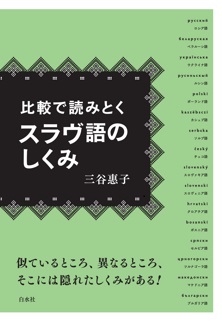
Title
Hikaku de Yomitoku: Slavic no Shikumi (Understanding through Comparison: Mechanisms of Slavic Language)
Size
244 pages, 127x188mm
Language
Japanese
Released
July 30, 2016
ISBN
978-4-560-08723-7
Published by
Hakusuisha Publishing
Book Info
See Book Availability at Library
Misc.
New version was published on 1/25/2025
Japanese Page
A linguistic primer on the Slavic languages, Understanding through Comparison: Mechanisms of the Slavic Languages is written in simple language so that even absolute newcomers to the Slavic languages can grasp the linguistic makeup and word structure and are actually motivated to study them.
Of course, there is no such language as “Slavic.” Most of the languages of the world fall into large “language families” with other neighboring languages connected by common linguistic roots. One such linguistic family, the “Slavic languages,” includes several languages that branched off from an ancestral language called “Proto-Slavic.” Specifically, the Slavic languages include Russian, Polish, Czech, Bulgarian, and Croatian—languages that were quite similar to each other until the 9th or 10th century and resembled regional dialects within a larger language.
Of these, Russian, Bulgarian, and Macedonian use the Cyrillic alphabet— for example, the word for “university” is “университет”—and Polish, Czech, and Croatian use the Latin alphabet— where the word “university” is written as “universitet.” With separate writing systems, the languages appear to be completely different, yet when we focus only on their sounds, we can see that they are still very similar, and that their basic vocabulary and grammar are often the same. However, more than 1000 years have passed since these languages branched out, and many differences have developed among the modern Slavic languages, which reflect their respective histories and social conditions. The book describes the features of the various Slavic languages, examining where these differences arise and how the languages have changed over time.
For example, in modern Russian, the word for “brother” is “брат” (or “brat” in the Latin alphabet); this word also has an identical spelling and meaning in Bulgarian and Macedonian. Now, as mentioned above, the Slavic languages descended from the ancestral Proto-Slavic. From this, we can easily infer that, in Proto-Slavic, the word for “brother” was “brat.” This assumption is correct. We can also further assume that if a word in a certain Slavic language contains the letter “a,” its counterparts in other Slavic languages should also contain the letter “a.” However, the Russian and Bulgarian counterparts of the Macedonian word “маж” (husband), containing the letter “a,” are “муж” and “мъж,” respectively. Even a person who cannot read the Cyrillic alphabet can see that although the first and last letters of these words, “м” and “ж,” are the same, the vowels in between, “a,” “y,” and “ъ,” are different. Why are the vowels in the words for “husband” different, while those in the words for “brother” are all “a”? Beginning with such questions, the book explains the similarities and differences in the structure of sounds, as well as aspects such as the features of the various grammatical forms and the differences among the various Slavic languages.
A list of study books and dictionaries on the Slavic languages available in Japan is provided at the end of the book.
(Written by MITANI Keiko, Professor, Graduate School of Humanities and Sociology / 2017)



 Find a book
Find a book


